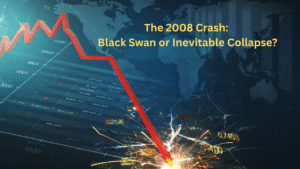 🧨 The 2008 Crash: Black Swan or Inevitable Collapse?
🧨 The 2008 Crash: Black Swan or Inevitable Collapse?
📘 Understanding the “Black Swan” Concept
Nassim Nicholas Taleb coined the term Black Swan to describe rare, unpredictable events with severe consequences. Could the 2008 crash be included in this concept? These events share three core traits:
- Rarity: They lie outside the realm of regular expectations.
- Impact: They carry massive ramifications.
- Retrospective Predictability: After they occur, explanations emerge that make them seem less random and more foreseeable.
The 2008 financial crisis was labeled a Black Swan due to its global shockwaves and the sheer scale of its impact. But when scrutinized through Taleb’s original lens, the “unpredictability” of the crash begins to crumble under a mountain of evidence.
🔍 The Storm Before the Storm: Warning Signs Ignored
1. Subprime Lending Explosion
The clearest red flag of problems coming was the rampant expansion of subprime mortgages. These were home loans given to borrowers with poor credit histories.
- By 2006, subprime mortgages accounted for nearly 20% of all U.S. home loans.
- Loan originators bypassed traditional income verification protocols, offering “liar loans” or “NINJA” loans (No Income, No Job, No Assets).
- Adjustable-rate mortgages (ARMs) lured borrowers with low initial payments that later spiked dramatically.
Financial institutions, under pressure to sustain profit margins, increasingly viewed these loans as short-term revenue streams rather than long-term liabilities.
2. Mortgage-Backed Securities (MBS) and Derivatives
Wall Street’s innovation turned shaky mortgages into supposedly AAA-rated investment vehicles.
- Mortgages were bundled into MBS, which were sold to global investors with the blessing of credit rating agencies.
- Collateralized Debt Obligations (CDOs) sliced these MBS into tranches, with risk hidden deep in the structure.
- The growth of Credit Default Swaps (CDS)—essentially insurance on these toxic assets—created a fragile web of interconnected risks.
This financial alchemy disconnected risk from responsibility. Institutions believed they had hedged their bets, while in reality they amplified systemic vulnerability.
3. Regulatory Apathy
The people in charge of scrutiny did not do their job. U.S. regulatory bodies appeared asleep at the wheel.
- The Office of Thrift Supervision and SEC were warned about the dangers of excessive leverage and mispriced risk as early as 2005.
- Even the Fed, under Alan Greenspan, showed reluctance to regulate derivatives markets or curb predatory lending.
- A 2006 speech by economist Nouriel Roubini starkly predicted a housing crash due to excessive debt and speculation. His words were dismissed as alarmist.
This failure to act wasn’t due to ignorance. It was rooted in ideology—a belief in market self-correction and minimal interference.
🏚️ The 2008 Crash: Why Didn’t More People See It Coming?
1. Incentive Structures
The markets thirst for Short-term gain trumped long-term sustainability.
- Lenders earned fees up-front with little concern for loan performance.
- Investment banks profited handsomely from securitization, passing risk down the line.
- Rating agencies received compensation from issuers, creating inherent conflicts of interest.
These incentives rewarded bad behavior. Warning signs were ignored because they interfered with profit.
2. Cognitive Bias and Groupthink
Even seasoned economists fell prey to optimism bias.
- The “this time it’s different” narrative dominated, convincing people that rising housing prices would offset any risk.
- Historical models were misapplied—valuations assumed perpetual market growth.
- Risk models relied on past data, failing to account for feedback loops and correlated asset failures.
Groupthink fostered complacency, especially among institutional analysts and political leaders.
3. Complexity and Opaqueness
The financial system’s interlinkages were too convoluted for most outsiders to decode.
- Risk was concentrated in shadow banking networks and derivative contracts with little transparency.
- Institutions themselves didn’t fully grasp their exposure.
- Stress tests failed to capture cross-institutional contagion risks.
This meant even those with the right instincts couldn’t fully quantify the danger.
🎓 So, Was It Truly a Black Swan?
If we return to Taleb’s three criteria:
| Criteria | Does 2008 Qualify? |
|---|---|
| Rarity | No — systemic vulnerabilities were known |
| Severe Impact | Yes — global financial disruption |
| Retrospective Clarity | Yes — many saw it coming post-mortem |
The 2008 crash fails the first condition. It was foreseeable—not necessarily in its exact timing or scope, but in its structural inevitability.
Taleb himself later clarified that while the crisis was a large-scale shock, its predictability disqualified it as a true Black Swan. Figures like Roubini, Michael Burry, and Meredith Whitney did anticipate the breakdown, even if they were considered fringe voices.
💬 The 2008 Crash: Lessons in Hindsight
1. Transparency and Accountability
Complex financial instruments need clear risk disclosure and real oversight. Regulators must prioritize public interest over market faith.
2. Long-Term Incentive Alignment
Structures that reward short-term profits while burying long-term liabilities should be reformed. Performance should be measured across time horizons.
3. Crowdsourcing Dissent
Crises emerge when dissenting voices are stifled. An ecosystem that values debate and challenges orthodoxy will be more resilient.
🧠The 2008 Crash: Black Swan or Inevitable Collapse?: Final Thoughts
Calling the 2008 crisis a Black Swan oversimplifies the dynamics of greed, risk mismanagement, and institutional blind spots that paved the way for collapse. It wasn’t an unforeseeable anomaly—it was a consequence of systemic neglect, veiled by a thin layer of optimism and market euphoria.
True unpredictability comes from unknown unknowns. In 2008, too many people knew, but too few listened.
And as we write this article, in 2025, the government in the USA is moving to relax more of the constraints that have been put on the financial system since the crash. Here we go again?
